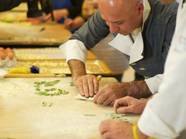"Italian American Women, Food an Identity": The Recipe of Membership
Food is not something that is limited to a product that must be consumed;, it goes far beyond.
Andrea L. Dottolo and Carol Dottolo, mother and daughter, and authors of the book "Italian American Women, Food, and Identity", know something about that.
But how did the idea for this book come about? The authors responded as follows:
"We had a casual conversation on the subject…, I wanted to find a way to look at Italian American women and their identity, in a way that they could talk about something easily".
This mother-daughter research explores the ways in which Italian American working women in Syracuse use food as a symbol and social vehicle in its multiple meanings. Since the study focuses on the intergenerational transmission of culture, the authors' relationship, and their similar and disparate experiences, reflects these themes.
The methodology of their work was based on requesting personal recipes of Italian dishes from the women of Syracuse (municipality of New York and capital of the county of Onondaga, whose name derives from the city of the same name located in Sicily) with questions related to their ideas and their feelings about food and being Italian American women.
The choice to engage the women of this place is not accidental.
"We are Italian-American and we grew up in this context, this microcosm,” say the authors, who then continue: "In my school 90% of the students were Italian. Syracuse was the unique, ideal place for our focus.”
The 23 women who participated in the research are from the post-war period, and therefore part of the baby – boom period, which sees these Western individuals as people who have helped to diversify the demographic of the United States. All respondents are between the ages of 58 and 69, belong to the working middle class and are heterosexual. They identify themselves as Italian American, or they have at least one immigrant parent or grandparent.
The authors provide an original contribution on the studied population through their avant-garde methodology of using the "recipe" as a research tool.
Here the word "recipe" resurfaces, like a common thread.
"Our interviews helped us to understand that flavors, aromas and ingredients were not just part of a process to be followed, but implied a set of values and ways of being," explain the authors.
And this is precisely the feeling that is transmitted to us: the "recipe" becomes a conversational bridge to arouse narratives about identity and self, a means to express who we think we are, who we want to be and who we are not.
Women and power, a combination that finds its field of action in the kitchen. According to the authors, women are masters of food. They take control and demonstrate their feelings through a delicious hot meal to serve to the people they love.
Of course, it was a discourse that does not include masculine nuance; they write only of feminism through cooking in a purely psychological and social introspection of how Italian American women are able to communicate a feeling through food.
In conclusion, this book successfully combines a multiplicity of lines of research focused on white ethnic populations, the link with food, and the perspectives of feminist psychology.
It is a perfect "recipe" to preserve Freedom, with a capital letter, and to be a part of something bigger.




































i-Italy
Facebook
Google+
This work may not be reproduced, in whole or in part, without prior written permission.
Questo lavoro non può essere riprodotto, in tutto o in parte, senza permesso scritto.